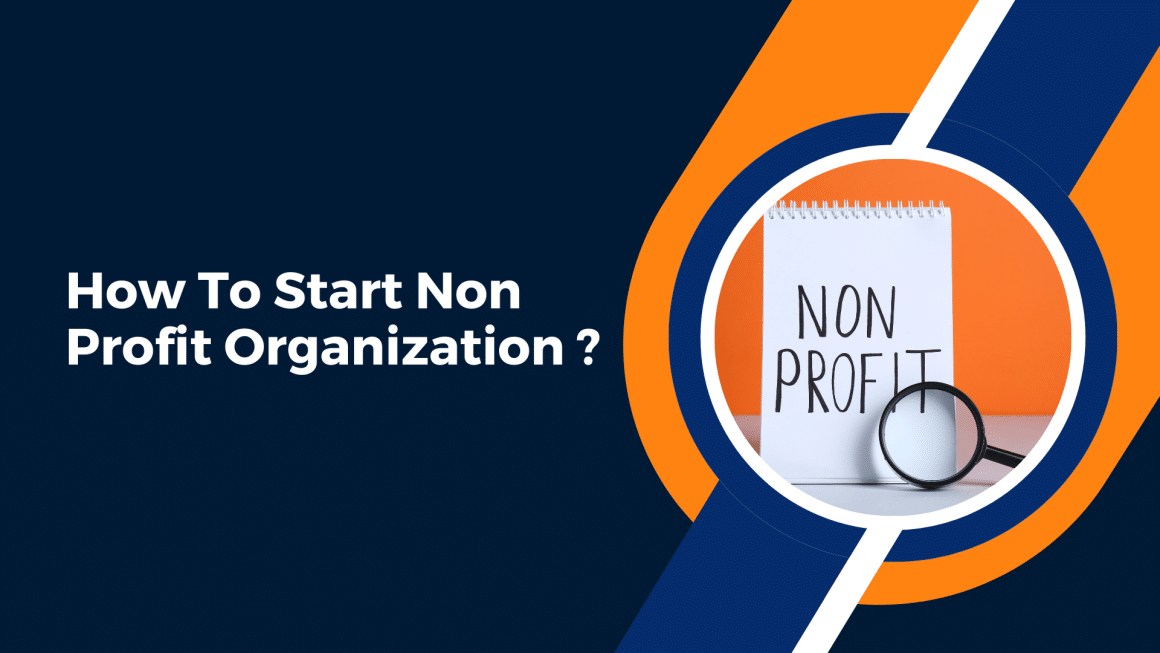This guide on how to start a nonprofit organization is a fulfilling venture that equips you with a clear roadmap. From crafting a compelling mission to navigating legal intricacies, you’ll learn the essentials. Find expert tips on board formation, fundraising, and achieving your nonprofit dreams without being overwhelmed. Let’s dive in!
Nonprofit organizations are like the heartbeats of our communities. They’re everyday superheroes making a big difference in the world. If you’ve ever thought about starting one, you’re on the right path to becoming a real-life hero.
Nonprofits aim to improve the world, addressing issues, fostering opportunities, and championing causes like hunger relief, environmental conservation, and education for disadvantaged youth. They tirelessly pursue these goals.
Apart from the gratification of making a positive impact, there are practical advantages. As the founder, you have the freedom to mold the organization according to your principles and aspirations. You’re in charge of determining the nonprofit’s operations.
And here’s the kicker – the tax benefits. Nonprofits often enjoy tax exemptions, which means more money can go toward the cause, not the taxman.
Don’t forget the impact. Nonprofits can create lasting change. They address issues that often fall through the cracks. Your nonprofit might be the spark that lights up a community.
What are nonprofit organizations?
So, you want to dive into the world of nonprofits, but what are they? Let’s break it down in simple terms.
- What’s a nonprofit organization?
- Nonprofit vs. for-profit
- Unique features of nonprofits
What’s a nonprofit organization?
At its core, a nonprofit organization is all about doing good. It’s an organization with a mission to make the world a better place. Instead of chasing profits, like for-profit companies do, nonprofits chase dreams. These dreams can be feeding the homeless, saving the environment, or spreading education.
Nonprofit organization vs. for-profit
The fundamental distinction between nonprofits and for-profits lies in their core purpose. For-profits are driven by profit-making, selling goods or services with the aim of generating revenue surpassing their expenses.
In contrast, nonprofits are driven by creating a positive impact. They raise money, too, but instead of personal gain, the money goes to a mission.
For-profits have owners who share the profits, but nonprofits have no owners. That’s right, no one’s getting rich from a nonprofit. Any money that comes in goes toward the cause.
Unique features of nonprofit organizations
Here’s where it gets interesting. Nonprofits have some cool features:
Tax-exempt: Nonprofits often don’t pay certain taxes, which means more funds for the mission.
Donations Matter: They heavily rely on donations. People, companies, and grants can donate to nonprofits, and it’s a big deal.
Mission-driven: Every nonprofit has a clear mission. It’s not just about making a product or offering a service. It’s about a higher purpose.
Community connection: Nonprofits tend to bring communities together. When people see a nonprofit working toward a good cause, they want to join in.
Transparency: Nonprofits are all about transparency. They share where the money goes so donors know their contributions are making a real impact.
Nurturing your nonprofit organization’s vision
Ready to start your nonprofit journey? It all begins with your passion and mission.
- Identifying your case or passion
- Defining your nonprofit’s mission
- Crafting a compelling mission statement
Identifying your cause or passion
The first step is figuring out what sets your heart on fire. What makes you go, “I want to change this!” It could be helping animals, fighting hunger, or supporting education. Take a moment to think about what keeps you up at night, what bothers you in the world, and what you’d love to make better.
Defining your nonprofit’s mission
Once you’ve pinpointed your passion, it’s time to define your nonprofit’s mission. This is like the
North Star that guides your organization. It’s your “why.” Ask yourself:
- What change do you want to bring?
- Who will benefit from it?
- How will you make it happen?
Your mission needs to be crystal clear and specific. Vague missions won’t cut it. It should inspire you and others to take action. If it’s too complicated, people might not understand it.
Crafting a compelling mission statement
Your mission statement is the heart of your nonprofit. It should be short, sweet, and powerful. A good one will make people nod their heads and say, “I want to be a part of that!”
A great mission statement should be the following:
- It should be clear and concise.
- Explain what you aim to achieve.
- Speaks to the heart and head.
- Motivates and inspires.
Legal and regulatory considerations when starting a nonprofit organization
Starting a nonprofit organization isn’t all passion and good deeds; there’s some paperwork and rules involved. Don’t worry; we’ll keep it simple.
- Legal structures for nonprofits
- Registering and incorporating your nonprofit
- Regulatory compliance and reporting
Legal structures for nonprofit organizations
First things first, you’ll need to pick a legal structure for your nonprofit. The most common one is the 501(c)(3). It’s like a golden ticket because it makes your organization tax-exempt. This means you won’t pay federal income tax, and your donors can get tax deductions. Nice, right?
Other options include 501(c)(4), 501(c)(6), and more, each with different rules and purposes. But if you’re going for that tax exemption and broad mission, 501(c)(3) is your go-to.
Registering and incorporating your nonprofit organizations
To make your nonprofit official, you’ll need to register and incorporate it. Here’s the lowdown:
Choose a Name: First, pick a unique and snazzy name for your nonprofit. Make sure it’s not already taken.
File articles of incorporation: This is like the birth certificate for your nonprofit. It states your mission, who’s in charge, and where you’re located. You’ll need to file this with your state’s business registration office.
Create bylaws: Bylaws are your organization’s rulebook. They explain how your nonprofit will run, who’s in charge, and how decisions get made. Think of them as your organization’s constitution.
Get an EIN: An Employer Identification Number (EIN) is like a social security number for your nonprofit. It’s used for tax purposes, so make sure to get one.
Apply for 501(c)(3) status: To enjoy that sweet tax exemption, you’ll need to apply for 501(c)(3) status with the IRS. This part can take some time, so be patient.
Regulatory compliance and reporting
Your nonprofit is up and running, but there are rules to follow:
Annual reporting: Nonprofits usually need to file an annual report with their state. This keeps the state updated on your activities.
Financial records: Keep detailed financial records. It’s not just for the IRS; it’s for your donors, too. Transparency is key.
Compliance with 501(c)(3) rules: If you’re a 501(c)(3), you must follow specific rules, like not engaging in too much political activity.
Fundraising regulations: Depending on your location, there might be rules about how you can raise funds. Make sure you follow them.
Stay transparent: Be open about how you’re using donations and what impact you’re making. Transparency builds trust.
Dealing with legal and regulatory matters may not be the most exciting part, but it’s vital to maintain your nonprofit’s good standing. Stay organized, adhere to regulations, and seek legal advice if needed. Establishing a strong legal foundation ensures you can continue creating a positive impact in the world without hiccups.
Building your nonprofit team
Your nonprofit dream is taking shape, and now it’s time to gather your superhero squad. Here’s how to do it:
- The role of a board of directors
- Recruiting a dedicated team
- Diversity and skill sets matter
The role of a board of directors
Picture your board of directors as the guardians of your nonprofit organization. They’re like the steering committee, guiding your ship to success. Here’s what they do:
- They set the big-picture goals and vision.
- They make important decisions, like hiring top staff.
- They ensure you’re following your mission and the law.
- They help with fundraising and keep an eye on the finances.
Your board needs to be made up of diverse, skilled folks who are as passionate about your cause as you are. Look for people who bring different strengths to the table. Some might be financial wizards, while others are marketing maestros. Together, they’ll help you steer the ship through calm and stormy seas.
Recruiting a dedicated team
Your core team isn’t just your board. It’s also the employees and volunteers who’ll roll up their sleeves and dive into the daily work. Here’s how to find them:
Start with passion: Look for people who genuinely care about your mission. When they believe in what you’re doing, they’ll give it their all.
Spread the word: Let the world know you’re looking for helpers. Use your website, social media, and local community networks to get the word out.
Network like a pro: Attend events related to your cause. You’re likely to meet like-minded individuals eager to join your mission.
Be a storyteller: Share your nonprofit’s story and impact. Inspire people with what you’ve achieved and what you plan to do. This can attract those who want to be part of your journey.
Diversity and skill sets matter
When assembling your team, diversity isn’t just a buzzword; it’s essential. Different perspectives, backgrounds, and experiences can lead to better decisions and more creative problem-solving.
Look for a mix of skills, too. If you’re an environmental nonprofit, you might need scientists, communicators, and project managers. The more varied talents you have, the more
well-rounded your organization will be.
Remember, your team is the backbone of your nonprofit. Their dedication, skills, and diversity can push your mission forward. Together, you’ll make a bigger impact than you ever could alone. So, go ahead and assemble your dream team of change-makers!
Fundraising and financial planning when starting a nonprofit organization
Money makes the nonprofit world go ’round. Let’s dive into the financial side of your mission.
- Exploring fundraising strategies
- Creating a nonprofit budget
- Insights on grant writing and securing financial support
Exploring fundraising strategies
Fundraising is like the fuel for your nonprofit engine. You need it to run smoothly. There are plenty of ways to gather the funds:
Individual donations: These are the heart of nonprofit funding. Regular people who believe in your mission can become monthly donors or give one-time contributions.
Events: Host fundraising events, like charity runs, galas, or auctions. They can be a fun way to raise money and create a buzz around your cause.
Online crowdfunding: Platforms like Kickstarter and GoFundMe can help you reach a broader audience. You tell your story, set a goal, and people chip in.
Grant writing: Grants are like mini-investments for your nonprofit. Look for foundations, government grants, and other organizations that support your cause.
Corporate partnerships: Sometimes, businesses want to team up with nonprofits for a win-win. They provide funding, and you help them meet their corporate social responsibility goals.
Creating a nonprofit budget
A budget is like your nonprofit’s roadmap for managing money. It keeps you on track and accountable. Here’s how to create one:
Income: List all the money you expect to come in, like donations, grants, and event income.
Expenses: Write down all your costs, such as staff salaries, rent, supplies, and marketing.
Be realistic: Estimate your income and expenses accurately. Don’t be too optimistic or too cautious.
Plan for surprises: Set aside some cash for unexpected expenses. In the nonprofit world, surprises can pop up.Prioritize your mission: Your budget should align with your mission if it doesn’t, rethink your spending.
Insights on grant writing and securing financial support
Grant writing is like telling a persuasive story to get funding. Here are some tips:
Research: Look for grants that match your mission. Read their guidelines carefully.
Tell your story: Explain your mission and what you’ll do with the grant. Make it compelling.Follow instructions: Grants often have specific requirements. Follow them to the letter.
Plan ahead: Grant applications can take time. Start early, so you’re not rushing.
Diversify your funding: Don’t rely on one source of funding. Spread the risk by getting money from different places.
Financial support can come from various avenues. The key is to be creative, persistent, and transparent about how you use the money. Keep your eye on the mission, and the funding will follow.
Fundraising and managing finances can be a juggling act, but it’s a vital one to keep your nonprofit going. The more efficiently you raise and manage funds, the more impact you can create. So, keep the money flowing and your mission growing!
Unlocking the potential of your nonprofit’s digital presence
In the digital age, your nonprofit’s online presence can be a game-changer. Let’s dive into why branding and marketing are essential, along with some tips for boosting your online presence.
- Significance of branding and marketing
- Tips for building an online presence and using social media
- The role of storytelling to attract donors
Significance of branding and marketing
You might think branding and marketing are for big companies, but they’re just as crucial for nonprofits. Here’s why:
Branding: It’s like your nonprofit’s personality. A strong brand helps you stand out and be memorable. When people see your logo or hear your name, they should instantly think of your mission and the good you do. It creates trust and recognition.
Marketing: This is how you share your story. Think of it as your megaphone to tell the world about your mission. Why does it matter?
- It raises awareness: People can’t support your cause if they don’t know about it.
- It builds trust: Consistent and clear messaging makes people feel more comfortable supporting you.
- It attracts donors: When people connect with your story, they’re more likely to open their hearts and wallets.
Tips for building an online presence and using social media
Your website is your online home base. It’s where people go to learn more about you and your work. Here’s how to make it shine:
- Keep it user-friendly: Your website should be easy to navigate. Don’t make people hunt for information.
- Share your story: Use your website to tell your mission’s story. People love stories, and they’ll connect with yours.
- Show impact: Display what you’ve achieved so far. When people see real change, they’ll want to be a part of it.
- Contact info: Make it easy for people to reach out or donate.
Social media is your best friend when it comes to spreading the word. Here are some tips:
- Choose your platforms wisely: Not all social media is created equal. Pick the ones that match your audience and mission.
- Be consistent: Post regularly so people know you’re active and committed.
- Engage with your audience: Respond to comments and messages. It shows you care.
- Use visuals: Pictures and videos catch people’s eyes and tell your story in a snap.
The role of storytelling to attract donors
Storytelling is your secret weapon. When you tell a compelling story, it’s like an invitation for people to join your mission. Here’s how to do it:
- Be authentic: Don’t sugarcoat things. Share the good and the struggles.
- Focus on individuals: Show how your mission impacts real people. It makes your cause relatable.
- Use visuals: A picture is worth a thousand words. Photos and videos help your story come to life.
Remember, your online presence is like a window into your world. Make it inviting, tell a captivating story, and engage with your audience. The more people connect with your mission online, the more support you’ll gather to make a difference in the real world. So, let’s get your mission out there!
Navigating common challenges for nonprofits: Solutions for sustainability and growth
Running a nonprofit organization can be like sailing through choppy waters, but with the right strategies, you can keep your mission afloat and steer toward long-term success.
- Identifying common challenges
- Solutions and strategies
- Long-term sustainability and growth
Identifying common challenges
Nonprofit organizations face their share of challenges. Here are some of the most common ones:
- Fundraising struggles: Keeping the money flowing can be tough. Donors might fluctuate, or economic conditions change.
- Volunteer burnout: Volunteers are the backbone of many nonprofits, but they can get tired or overwhelmed.
- Legal and compliance hurdles: Navigating the legalities and regulations can be tricky. It’s easy to get lost in paperwork.
- Competition for attention: There are many nonprofits out there, all vying for attention and support.
Solutions and strategies
Facing these challenges head-on is key. Here are some strategies to overcome them:
- Diversify fundraising: Relying on one source of funding is risky. Explore different fundraising methods to spread the risk.
- Volunteer engagement: Keep your volunteers motivated. Recognize their efforts, and offer opportunities for growth and leadership within your organization.
- Legal assistance: Don’t go it alone. Seek legal advice when needed to ensure compliance with regulations and to handle any legal issues that arise.
- Differentiate your cause: Find what makes your nonprofit unique and spotlight it. Clearly communicate your impact and why you deserve support.
Long-term sustainability and growth
To make your nonprofit last and grow, consider these steps:
- Strategic planning: Develop a strategic plan that outlines your long-term goals and how to achieve them.
- Financial sustainability: Build up a financial reserve to weather tough times. Cut unnecessary expenses and invest wisely.
- Collaborate and network: Partner with other nonprofits or organizations that share your mission. Collaboration can open new opportunities.
- Adaptability: Be flexible and ready to adapt to changing circumstances. Sometimes, your initial plan may need adjustments.
- Impact measurement: Continually measure and showcase the impact of your work. Transparency can keep your supporters engaged and attract new ones.
Remember, challenges are part of the nonprofit journey, but they don’t have to be roadblocks. With determination, smart strategies, and adaptability, you can keep your nonprofit sailing toward your mission’s horizon. Sustainability and growth are possible, and your impact can endure for years to come.
Measuring and showcasing your nonprofit organization’s impact
Your nonprofit organization’s impact is like the heartbeat of your mission. Let’s explore how to measure and showcase the good you’re doing.
- Setting goals and key performance indicators (KPIs)
- Measuring and showcasing impact
- The importance of adaptability and learning from outcomes
Setting goals and key performance indicators (KPIs)
To measure your impact, you first need to set clear goals and Key Performance Indicators (KPIs). Think of goals as the big picture—what you want to achieve. KPIs are the smaller, measurable steps to get there.
Here’s how to do it:
- Be specific: Define your goals and KPIs in precise terms. Instead of “helping kids,” say “providing educational support to 500 underprivileged children.”
- Make it time-bound: Set a timeline for achieving your goals. Will you educate those children in a year or two?
- Track progress: Regularly monitor your progress toward your KPIs. Are you on track, or do you need to adjust your strategy?
Measuring and showcasing impact
Now comes the exciting part—measuring the impact of your work. It’s all about showing the world the real change you’re making. Here’s how:
- Data collection: Collect data that relates to your KPIs. This could be the number of kids you’ve educated or the decrease in pollution due to your environmental efforts.
- Tell stories: Numbers are powerful, but stories touch the heart. Share stories of individuals whose lives have improved thanks to your nonprofit’s work.
- Visuals: Use visuals like infographics or charts to make your data more understandable and memorable.
- Transparency: Be transparent about how you measure your impact and what you’ve achieved. Donors and supporters appreciate openness.
The importance of adaptability and learning from outcomes
Here’s a secret: not everything will go as planned. Sometimes, you’ll fall short of your KPIs, and that’s okay. What matters is how you adapt and learn from your outcomes.
- Adapt to challenges: When you face roadblocks or challenges, be ready to adapt your strategies. Don’t be afraid to pivot when needed.
- Learn and improve: Every outcome, whether good or not-so-good, holds a lesson. Learn from them, and use that knowledge to do better next time.
- Feedback loop: Listen to feedback from your team, donors, and beneficiaries. They might have insights you haven’t thought of.
- Flexibility: Flexibility is your friend. Being open to change can lead to unexpected opportunities and improvements.
Measuring your nonprofit’s impact isn’t just about statistics; it’s about telling the world how you’re making a difference. Setting clear goals, tracking progress, and staying adaptable are the keys to showcasing your success. As you learn and grow, your impact will ripple out and continue to make the world a better place.
FAQ’s
Can you start a nonprofit alone?
Yes, you can kick start a nonprofit organization solo, but it’s not a one-person show in the long run. Starting alone lets you lay the foundation, but building a team is crucial. Nonprofits need passionate people, so gather supporters who share your vision.
A team brings diverse skills and more impact. So, while you can plant the seed alone, your nonprofit grows and thrives with a dedicated group working together. Don’t hesitate to reach out and find your fellow changemakers.
Is it hard to start a nonprofit?
Starting a nonprofit organization has its challenges, but it’s not an Everest-sized task. It’s like planting a garden. You need a plan, patience, and some effort. It involves paperwork and legal stuff, but many resources and guides are out there.
The key is your passion for the cause. If you’re driven and willing to learn, you can do it. Don’t go it alone—seek advice, connect with other nonprofits, and gather a supportive team. The journey might have bumps, but it’s worth it when you see the positive impact your nonprofit creates.
Conclusion
Embarking on the path to start a nonprofit organization is a remarkable endeavor, and you’ve just been equipped with the essential roadmap.
To recap, find your passion, establish a strong legal foundation, build a dedicated team, master fundraising, create a compelling online presence, navigate challenges, and measure your impact. Now, it’s time to put your passion into action, no matter how small the first step may be.
The world needs your mission, and every positive change begins with that initial leap. You’re not alone on this journey, so seek support, mentorship, and valuable resources from the nonprofit community. Your dream is worth pursuing, and it has the potential to leave a lasting, positive mark on the world. So, go forth, inspire, and make a difference—your mission awaits.



